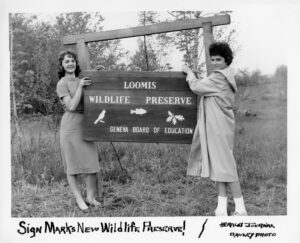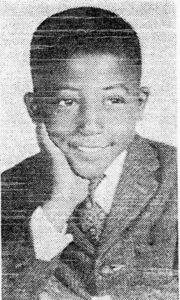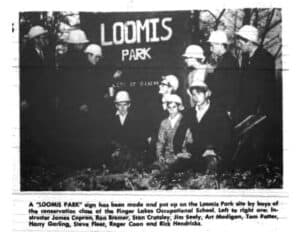Over the River and Through the Woods: Loomis Wood
By Becky Chapin, Archivist

An undated PB Oakley photo from his Syracuse Herald-Journal collection shows a new sign for the Loomis Wildlife Preserve being hung by two unidentified girls.
At the turn of the 20th century, the City of Geneva was regularly discussing the creation of park land within its borders. In 1901, the Park Board was formed with duties to include overseeing a park fund, acquiring land for parks, and caring for all city parks. While its biggest goal was to create a park along the lakefront, there were other locations in Geneva which were seen as valuable.
Mayor Arthur P. Rose was especially interested in a wooded area along the northern border that split the city and town. The woods were part of a large tract of land that was owned by Henry Loomis, whose family had settled it as early as 1788. Mayor Rose approached Henry many times to discuss deeding a portion of the wooded area to the city for use as a park, but it wasn’t until 1909 that the discussions became reality.
Ancestors of the Loomis family were already known for giving land in New York City for parkways, and Henry, with his sister Cordelia, had often expressed a desire to do something similar for Geneva. When Cordelia died in early 1909, it was reported that she had revived this desire to Henry just weeks prior; the newspaper said: “Mr. Loomis considers it as a sort of sacred request, which he is bound to fulfill.”
Henry visited the city’s attorney in February 1909 after a visit with Mayor Rose and Anne Fitzhugh Miller, whom Rose had recruited to his cause. At first, Henry gifted 15 acres of his wooded property on the west side of Carter Road. The deed was specific, stating that the “land named shall be a public park and playground and that it shall be called ‘Loomis Park’ as a memorial to the memory of Henry Loomis and his sister Cordelia C Loomis.” In April 1909, he decided to gift a further 15 acres that extended down North Street.
But this second gift came with a stipulation. The city was required to set up a fund of $10,000, of which the interest should be used for the maintenance of Loomis Park and other city parks, and create a finance commission to have charge of the fund and administer it. The Common Council balked at both stipulations but made attempts to raise the money through appealing to the public via subscriptions. The city struggled to raise even half the requested amount, despite Henry lowering the fund requirement to $5,000.
The city tried negotiating with Loomis, through his attorney, but eventually Henry withdrew the second gift in October 1909, disgusted with the handling of the matter and the lack of public support (this lack of support for park land was not unusual for the time). In December 1909, the council acceded to the request and the land was restored. Despite the loss of a second 15 acres, the city still maintained control of the original 15 which was being called Loomis Park.
Henry Loomis died in 1913 at age 96. Neither the Council, nor the Park Board, did much with the land in the following decades. Mentions of Loomis Woods in the paper during the first half of the century rarely go beyond a small mention of small groups using the land for hikes, picnics, and meetings. Arthur Dove reportedly explored the area during his brief return to Geneva in the 1930s and poet Edwin Becker dedicated his book Out of the Finger Lakes Country Part III to Loomis Woods.
Various plans were proposed which included clearing away the tangled undergrowth, cutting out dead trees, and placing picnic tables but there was a desire to keep the land in its original state. During World War 1, a small section was used for war gardens with plots assigned to various citizens for growing vegetables to “help win the war” and some gardens were kept for several years after.
After two years of negotiations, the Common Council approved a lease between the city and the Geneva Board of Education in 1957 for use of the Loomis Woods tract. The BOE was sponsoring a nature study program in conjunction with the school’s Conservation Education Committee which included plans to build a pond for the purpose of propagating fish, turtles, frogs, water plants, and other flora/fauna.

Gary Alfred Moore, as pictured in the Geneva Times following his death in 1966. His friends and the fire department tried to save him, but he was declared dead at the hospital.
Unfortunately, the pond was the site of two tragic deaths within eight years. Floyd Ferris Jr., 13, drowned in 1958 when he went swimming alone in the pond, prompting talks of adding signs and fencing. No fencing was put up and the signs were torn down within weeks. School officials still felt that with no deep drop offs there was little danger involved for youngsters. Gary Alfred Moore, 12, drowned in 1966 when he was fishing with friends. The pond was then drained and abandoned.
In 1959, work began to clear the underbrush, but was still mostly left alone until the early 1960s. Students at the new North Street Junior High School established the Loomis Woods Nature Trail under the direction of the Conservation Education Committee, but that too was left to revert to nature.
The Geneva Loomis Woods Hometown Beautification Project was launched in July 1968 as a seven-week project designed to develop an overgrown section of the woods into a park. Under the direction of the Geneva Recreation Department, ten young persons were hired to work on the project through a NYS Division for Youth program. Work included clearing dense underbrush, selective thinning and trimming of trees, drainage of the remaining water from Loomis Pond, setting up the picnic area, and the development of a nature trail. The work continued for a couple more years to clear different sections.

A group of youths constructed a sign for Loomis Park during the first year of the Beautification Project and pose with the product.
The 1970s brought Loomis Woods into a city discussion over the planning of a new recreation site. Several years of planning eventually led to the decision to construct the South Exchange Street skating rink as it is today, but there was much controversy regarding the possible development of Loomis Woods.
In spring 1985, the Board of Education gave permission to Cub Scout Pack 5 to reestablish the nature trail for educational uses by the local students and general Geneva public. The cub scouts, Troop 4 BSA, and conservation students at FLCC continued to maintain the trail for several years. In 2005, as part of an Eagle Scout project, a second set of sign markers were installed on the trail. The school district continues to use the land for science lessons, nature walks, physical education units, a pumpkin walk, and other activities.

I would like to bring back the loomis pond project.
I’m currentlythe City of Geneva ny ward 4 Council Representative.
who do I reach out to for assistance.
Pete
I remember Gary Moore who drowned in Loomis Pond in 1966. I hopped on my bicycle to follow the fire trucks and ambulance to the pond and got there just as the fireman were pulling Gary’s lifeless body out of the water. Unfortunately resuscitation efforts were not successful.
I would say let sleeping dogs lie, don’t rebuild Loomis Pond but if you do, don’t make it more than a few feet deep ie: so if any young person falls in the water they can just stand up.